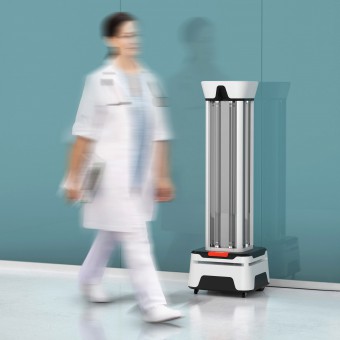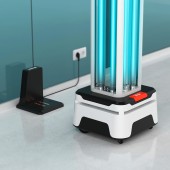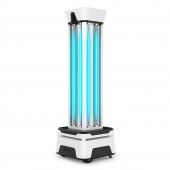DESIGN NAME:
Desibot
PRIMARY FUNCTION:
Intelligent Disinfection Robot
INSPIRATION:
The idea for design of automated disinfection robot was dictated by the COVID-19 virus. Since the beginning of the global pandemic there was a clear need to disinfect various public spaces from the spread of the SARS‑CoV‑2 without using chemicals. While mass-produced disinfection robots had a high retail price, a combination of 3D printed automated robot on demand with integrated UV light seemed to be an efficient and safe way to ensure safety of workers and clients at a reasonable price range.
UNIQUE PROPERTIES / PROJECT DESCRIPTION:
Desibot is a modern autonomous indoor robot with intelligent ultraviolet light disinfection function to prevent virus and bacteria spread. Product system is designed to provide a sterile environment in hospitals and clinics without using chemicals or putting workers and clients to unnecessary risk. Usage of automated robotic solutions increases the safety of personnel as they do not need to handle, transport or store toxic, hazardous or corrosive chemicals.
OPERATION / FLOW / INTERACTION:
The main principle based on ultraviolet radiation and the performance of the equipment is clinically tested. Recent research shows that a robot emitting concentrated UV-C light destroys up to 99.99% of bacteria, viruses, molds, fungi and other microorganisms, including known pathogens such as SARS-CoV-2. Autonomous robots can effectively disinfect various spaces without human interaction. Desibot uses LIDAR space scanning and mapping technology for navigation and autonomous movement. Robot’s artificial intelligent cameras detect if a person enters the disinfection space and immediately turns off the lights due to the enhanced sense of security. It takes approximately 10-15 minutes to disinfect one operating room without any need to maintain the exposure or ventilate the premises. No chemicals are used.
PROJECT DURATION AND LOCATION:
At the beginning of the global pandemic, everything was missing: masks, protective equipment, and even disinfectant. At that time robotic specialists came up with the idea to create a robot to disinfect the premises to fight a life-threatening virus. Project technological research has started in the middle of 2020 in Vilnius, Lithuania. In the middle of 2021 technical solutions were developed and the product design process started with visionary sketches. By the end of the same year primary ideas were successfully transformed to 3D drawings and visuals. After that physical tangible prototypes were created. In the beginning of 2022 first prototypes were ready to roll first testing environments.
|
PRODUCTION / REALIZATION TECHNOLOGY:
The main casing of the robot is manufactured with 3D printing technology. This solution allows product to be manufactured locally in small amounts according to the need. FDM or SLS printing technology allows Desibot to be personalised if needed according to the client’s branding or the environment where it is going to be used.
SPECIFICATIONS / TECHNICAL PROPERTIES:
Disinfection robot: 420 mm (width) x 420 mm (depth) x 1300 mm (height)
Charging dock: 250 mm (width) x 250 mm (depth) x 270 mm (height)
TAGS:
Disinfection Robot, Ultraviolet, Covid, UV-C Radiation, UV lamp, Desdorp, Desibot
RESEARCH ABSTRACT:
During the market research it was found that the price range of disinfection robots is extremely high. In an environment that poses a threat to society, the UV robot is relevant and in great demand. In order to meet the market requirements and stay competitive Desibot solution supposed to be innovative on every level. A combination of intelligent hardware solutions and innovative manufacturing on demand with 3D printing technology made it possible to speed up and reduce the cost of product design, prototyping and production. That increased accessibility for a wide range of consumers. All features were blended together into one intelligent UV disinfection robot, which we call Desibot.
CHALLENGE:
The main creative challenge was to design unobtrusive aesthetic forms of the disinfection robot which were going to be manufactured in small amounts with 3D printing technology. The requirements for each part of the product design should meet highest rigidity to hold components and reliability for steady and precise usage. Some of the standard ready-made attachments were redesigned and integrated into the main forms.
ADDED DATE:
2022-03-30 06:02:31
TEAM MEMBERS (2) :
Design: Desdorp (Deividas Juozulynas, Denis Orlenok, Danil Ščepanov) and Hardware and electronics: UAB “Geobaltic” (Mantas Budraitis)
IMAGE CREDITS:
Desdorp, 2022
|









